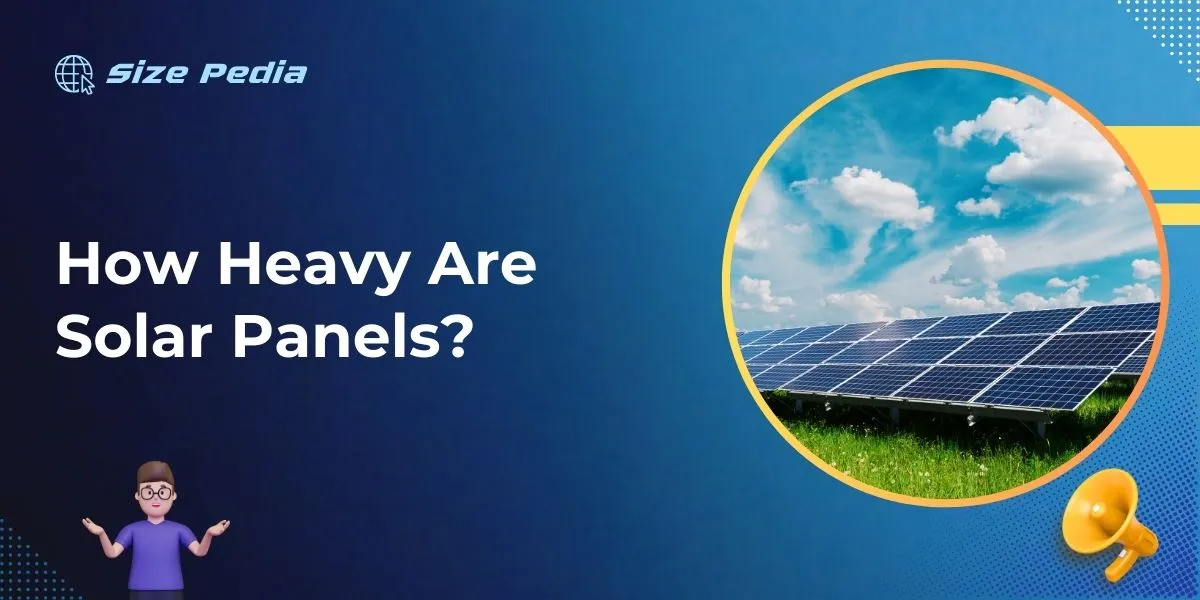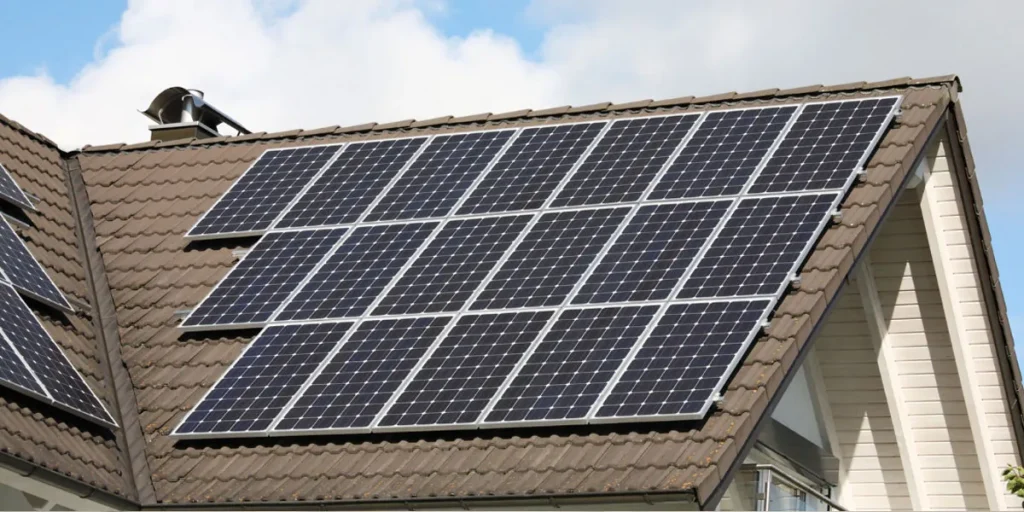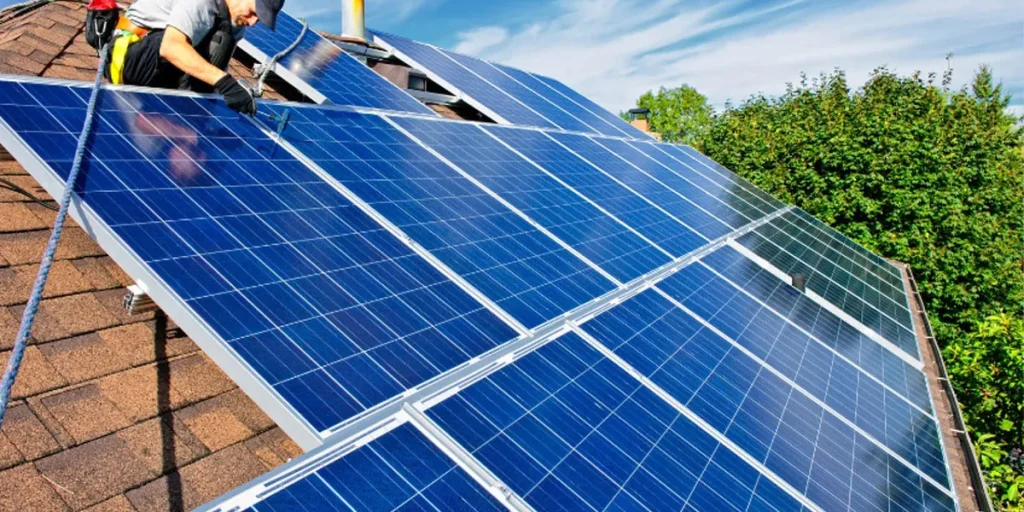Solar panels typically weigh between 18 to 50 pounds (8 to 23 kg). Standard residential panels average 40 pounds (18 kg) in weight.
Solar panels are an integral component of any solar energy system, offering a sustainable solution to power needs.
The weight of a solar panel is an essential aspect to consider, especially during installation and roof assessments.
Residential and commercial buildings require a thorough analysis to ensure their structures can support this additional weight.
The standard dimensions for residential solar panels, which are about 65 inches by 39 inches, contribute to their average weight, with variations based on the materials used and the number of cells in a panel.
For those considering solar panel installation, understanding weight specifications is crucial to ensure safety, longevity, and efficacy of the solar energy system.
With green energy on the rise, the importance of solar technology and the practical details of its implementation have become more pertinent than ever.

Solar Panels Weight Significance
Solar panels weight significance plays a crucial role in solar system planning and installation.
Understanding the weight is key to the safety and efficiency of the solar project. Let’s delve into the aspects of weight and its impact on both roof support and transportation.
Importance For Roof Support
Durable roof support is essential for solar panel installation.
- Solar panels typically weigh around 40 pounds each.
- Roofs must hold these panels plus natural loads like snow.
Assessing weight distribution prevents roof damage. Engineers study these factors before installation. They guarantee your roof can support solar panels safely.
Impact On Transportation
The weight of solar panels influences transportation logistics.
- Heavier panels mean fewer units per shipment.
- Special equipment may be needed for loading and unloading.
Transport costs can affect the overall solar system budget. Lighter panels promote easier and cost-effective transport. Knowing their weight helps with efficient project planning.
Average Weights Of Common Solar Panels

When diving into the world of solar energy, it’s essential to understand how much solar panels weigh. The weight influences installation methods and structural support.
Various types of panels come with distinct weights. Here, explore the average weights of commonly used solar panels in both residential and commercial settings.
Residential Vs. Commercial Panels
Residential solar panels are typically lighter than commercial panels. This difference is due to size and power capacity needs.
- Residential solar panels usually weigh between 40 to 50 pounds each.
- Commercial solar panels are larger, coming in at about 50 to 70 pounds.
Residential solar installations often feature panels around 5.5 feet by 3.25 feet in size. On the other hand, commercial panels can be larger, hence the extra weight.
Thin-film Vs. Silicon Panels
The main materials used in solar panels directly affect their weight. Let’s compare.
| Panel Type | Average Weight |
|---|---|
| Thin-Film Panels | Less than 1 pound per square foot |
| Silicon Panels | Approximately 2 to 4 pounds per square foot |
Thin-film panels are much lighter, making them easier to install on a variety of surfaces. Silicon panels, while heavier, often provide higher efficiency.
Factors Influencing Solar Panel Weight

Understanding the weight of solar panels is vital before installation. Several factors can influence this. Knowing these will ensure you choose the right type for your needs.
Material Composition
The materials used in solar panels play a huge role in their overall weight. Most panels have silicon cells, metal framing, and glass casing.
Different types of silicon, like monocrystalline or polycrystalline, vary in weight. The frame, usually aluminum, adds to the weight but also provides durability.
- Monocrystalline silicon: High-purity, heavier
- Polycrystalline silicon: Slightly lighter
- Frame materials: Can be aluminum or steel
Size And Thickness
Bigger solar panels naturally weigh more. However, size isn’t the only factor. Thickness can impact weight too.
Thicker glass or frames increase durability but also add pounds. Panels come in various sizes, commonly measured in watts of power output.
| Panel Size (Watts) | Typical Dimensions (Inches) | Approx. Weight (Pounds) |
|---|---|---|
| 100 | 47 x 21.3 | 16.5 |
| 250 | 64.57 x 39.06 | 40 |
| 300 | 65.9 x 39 | 48 |
Smaller solar panels are lighter and easier to handle. They suit small-scale installations like residential rooftops. Large commercial panels need more support due to their weight.
Structural Considerations For Installation
Planning to install solar panels is a step towards sustainability. Understanding the weight of solar panels is crucial.
This ensures the roof can support them. Proper assessment and possible reinforcement set the scene for safe installation.
Roof Assessment
Before installing solar panels, inspect the roof thoroughly. This check determines if the structure can bear the panels’ weight. Professional evaluation involves looking at:
- Roof type and material
- Age and current condition
- Previous modifications or damages
The pitch and layout affect how panels sit and distribute their weight. Failure to conduct a robust roof assessment could lead to structural damage and costly repairs.
Reinforcement Techniques
If the assessment shows need for extra support, reinforcement techniques come into play. These enhance the roof’s load-bearing capacity.
Methods vary based on roof type and condition. Some options include:
- Installing additional rafters or trusses
- Strengthening existing rafters with steel plates
- Using tension rods for added support
It’s key to work with licensed professionals for reinforcements. They ensure compliance with local building codes.
Safe and efficient panel installation is the goal. Well-executed reinforcements prevent future structural issues.
Tips For Safe Handling And Installation
Tips for Safe Handling and Installation of solar panels ensure efficiency and safety. Solar panels typically weigh between 15 to 50 pounds each.
Their size and heft necessitate proper handling. In the next sections, we’ll dive into how to manage their weight securely and avoid injury.
Lifting Techniques
Proper lifting techniques are crucial to avoid strain or injury. Here are some steps to follow:
- Bend your knees and keep your back straight
- Use your legs to lift, not your back
- Carry the panel close to your body
- Avoid twisting your torso while carrying
- Work in teams when lifting panels heavier than 25 pounds
Use Of Proper Equipment
Employing the right tools can significantly ease the process. Consider the following:
| Equipment | Function |
|---|---|
| Panel Lifting Device | For hoisting panels onto the roof |
| Safety Harness | Prevents falls while working at height |
| Gloves | Improves grip and protects hands |
| Knee Pads | Provides knee support during installation |
Make sure to inspect all equipment before use. Broken or damaged tools must not be used for handling solar panels.
Future Trends In Solar Panel Design
As the solar industry evolves, so does solar panel technology.
The latest designs promise more efficiency and easier handling.
This means solar panels are not just getting smarter; they’re also becoming lighter.
Here we’ll explore exciting trends set to revolutionize solar panel design.
Lightweight Materials
Traditional solar panels can be quite heavy, posing challenges for installation and structural integrity.
But change is in the air. Researchers are developing new materials for solar panels that could reduce their weight significantly.
These materials include advanced composites and flexible, thin-film technologies.
Lightweight solar panels offer many benefits:
- Easy transport
- Simple installation
- Less stress on building structures
- Better suitability for non-traditional locations, like vehicles or temporary setups
Innovations Reducing Installation Load
The future shines bright with innovations focused on streamlining the installation process.
Let’s look at some innovations that can make solar setups lighter:
- Integrated solar roofing materials
- Plug-and-play solar panels
- Improved solar panel frames and mounting systems
Such advancements will not only reduce the labor needed for installation but also cut down on the overall time and equipment required.
Less weight means more flexibility in where we can install solar panels.
Keep an eye on these trends—they’re set to brighten the way we harness the sun’s power!
FAQs About the Weight of Solar Panels
What Is The Average Weight Of Solar Panels?
Solar panels typically weigh around 40 to 50 pounds (18 to 23 kilograms).
This weight can vary based on the size and make of the panel. Standard residential panels are generally this heavy.
How Does Solar Panel Weight Affect Roof Installation?
The weight of solar panels can influence the structural support your roof requires.
Installers assess the roof’s load-bearing capacity to ensure it can support the panels.
Proper assessment and reinforcement, if needed, guard against any potential damage.
Can Heavy Solar Panels Be Installed On Any Roof Type?
Not all roofs can sustain the weight of heavy solar panels. Factors like roof material, angle, and condition determine suitability.
Professional evaluation is essential to decide if additional support structures are necessary.
Do Larger Solar Panels Weigh More?
Generally, larger solar panels come with increased weight due to more materials used.
However, advancements in technology can result in lighter panels with comparable power generation. The weight is not strictly proportional to size.
Conclusion
Understanding the weight of solar panels is essential when planning your renewable energy setup. Panels vary in size and weight, impacting installation and roof requirements.
Always consider load calculations and professional advice for optimum safety and efficiency. Embrace solar energy with confidence, knowing you’re prepared for the physical demands.
Resources:
https://www.energy.gov/eere/solar/homeowners-guide-going-solar
https://www.nrel.gov/research/re-solar.html
